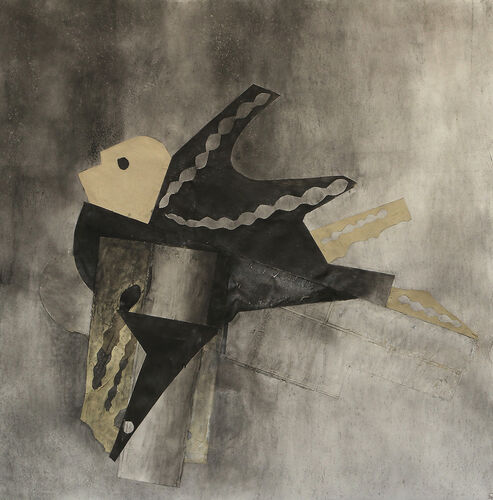Georg Dionysius Ehret
Gloriosa superba (Glory Lily)
Estimate: 25.000 - 35.000 GBP
Price realised: 30.550 GBP
Price realised: 30.550 GBP
Description
Georg Dionysius Ehret (1708-1770)
Gloriosa superba (Glory Lily)
signed 'G.D.Ehret Pinx' (lower right) and inscribed 'Methonica Malabarorum H.L.B. app.' (lower centre)
pencil and watercolour on vellum, heightened with white
20 7/8 x 14½ inches (530 x 368mm.)
AN EXCEPTIONAL IMAGE OF THE GLORY LILY. Ehret portrays this elegantly beautiful plant at three stages of flowering from small bud to full flower, as well as showing a ripe seed pod, and examples of the seeds themselves. A native of tropical Africa and Asia, and a member of the Liliacae family, the Glory Lily is a slender herbaceous vine growing from a thick tuberous rootstock with slender strap-like leaves with tendril-like tips, the spectacular flowers are born on long stalks. All parts of the plant, especially the tubers, contain highly poisonous alkaloid toxins.
The reference 'H.L.B. app.' refers to Paul Hermann's Horti Academici Lugduno-Batavi catalogus exhibens plantarum omnium nomina (Leiden: 1687), an important catalogue of the Leiden university botanic garden's exotic plants including the Glory Lily, named by Hermann 'Methonica Malabarorum'. This name was later rejected by Linnaeus in favour of 'Gloriosa superba'.
This drawing is a finished version of an image that is also known from a preliminary pencil and watercolour drawing on paper, now in the Natural History Museum in London (see G.Calmann Ehret Flower Painter Extraordinary [1977] p.110 and illustrated as plate 84). This preliminary sketch was part of an album of 248 sketches on paper, a number of which can be shown to be initial ideas for Trew's Plantae Selectae (1750-1773) and Ehret's Plantae et Papiliones Rariores (1748-1749). Given Ehret's demonstrable willingness to accept Linnean nomenclature and the publication dates of 1747, 1748 and 1750 mentioned above, the present drawing can plausibly be dated to the 1740's.
Gloriosa superba (Glory Lily)
signed 'G.D.Ehret Pinx' (lower right) and inscribed 'Methonica Malabarorum H.L.B. app.' (lower centre)
pencil and watercolour on vellum, heightened with white
20 7/8 x 14½ inches (530 x 368mm.)
AN EXCEPTIONAL IMAGE OF THE GLORY LILY. Ehret portrays this elegantly beautiful plant at three stages of flowering from small bud to full flower, as well as showing a ripe seed pod, and examples of the seeds themselves. A native of tropical Africa and Asia, and a member of the Liliacae family, the Glory Lily is a slender herbaceous vine growing from a thick tuberous rootstock with slender strap-like leaves with tendril-like tips, the spectacular flowers are born on long stalks. All parts of the plant, especially the tubers, contain highly poisonous alkaloid toxins.
The reference 'H.L.B. app.' refers to Paul Hermann's Horti Academici Lugduno-Batavi catalogus exhibens plantarum omnium nomina (Leiden: 1687), an important catalogue of the Leiden university botanic garden's exotic plants including the Glory Lily, named by Hermann 'Methonica Malabarorum'. This name was later rejected by Linnaeus in favour of 'Gloriosa superba'.
This drawing is a finished version of an image that is also known from a preliminary pencil and watercolour drawing on paper, now in the Natural History Museum in London (see G.Calmann Ehret Flower Painter Extraordinary [1977] p.110 and illustrated as plate 84). This preliminary sketch was part of an album of 248 sketches on paper, a number of which can be shown to be initial ideas for Trew's Plantae Selectae (1750-1773) and Ehret's Plantae et Papiliones Rariores (1748-1749). Given Ehret's demonstrable willingness to accept Linnean nomenclature and the publication dates of 1747, 1748 and 1750 mentioned above, the present drawing can plausibly be dated to the 1740's.
A top price for Georg Dionysius Ehret - as previously expected
In June 2001 Christies in London held the auction NATURAL HISTORY, which included the work Gloriosa superba (Glory Lily) by Georg Dionysius Ehret. The price achieved of GBP 30,550.00 (€ 50,749.63) was within expectations - the estimate range had previously been set by the auction house as GBP 25,000.00 – 35,000.00. Even if this result could not surprise positively, Gloriosa superba (Glory Lily) is the most expensive artwork by Georg Dionysius Ehret that we have observed at auctions so far.
Ein Spitzenpreis mit Ansage
Im Juni 2001 führte Christies in London die Auktion NATURAL HISTORY durch, in der auch die Arbeit Gloriosa superba (Glory Lily) von Georg Dionysius Ehret zur Versteigerung kam. Der dabei erzielte Preis von GBP 30.550,00 (€ 50.749,63) lag im Rahmen der Erwartungen – die Schätzpreisspanne war von dem Auktionshaus zuvor mit GBP 25.000,00 – 35.000,00 angegeben worden. Auch wenn das Ergebnis damit nicht positiv überraschen konnte, ist Gloriosa superba (Glory Lily) das teuerste Kunstwerk von Georg Dionysius Ehret, das wir bisher bei Auktionen beobachtet haben.

















![Imao Keinen - Keinen kacho gafu [Keinen\'s natural history paintings] Kyoto: printed by Harubei Tanaka for S. Nishimura, 1891-1892. 4 volumes, 2° (370 x 257mm). 135 coloured wood-block plates on 162 leaves (including 27 \'diptych\' plates). (Wormtrack running through firs](/images/imao-keinen_keinen-kacho-gafu-keinens-natural-history-paintings-kyoto-printed-by-harubei-tanaka-for-s-nishimura-1891-1892-4-volumes-2deg-370-x-257mm-135-coloured-wood-block-plates-on-162-leaves-including-27-diptych-plates-wormtrack-running-through-first-2_AID936995_320x320.jpg)

![Jacques Barraband - Violet-necked Lory (Plate no. 51, Le Lori Ecaille, Eos squamata. Sheet size 19¾ x 12 inches [502 x 310mm.])](/images/jacques-barraband_violet-necked-lory-plate-no-51-le-lori-ecaille-eos-squamata-sheet-size-193-4-x-12-inches-502-x-310mm_AID936981_320x320.jpg)

![Pierre Joseph Redoute - Choix des Plus Belles Fleurs Prises dans Différentes Familles du Règne Végétal Text by D.-M. Guillemin. Paris: C.L.F. Panckoucke, 1827 [-1833]. Large 4° (335 x 244 mm.) Title-page, advertisement and 9 leaves of text (paginated 1-17 and final blanc), 144 f](/images/pierre-joseph-redoute_choix-des-plus-belles-fleurs-prises-dans-differentes-familles-du-regne-vegetal-text-by-d-m-guillemin-paris-c-l-f-panckoucke-1827-1833-large-4deg-335-x-244-mm-title-page-advertisement-and-9-leaves-of-text-paginated-1-17-and-final-blan_AID936967_320x320.jpg)
















